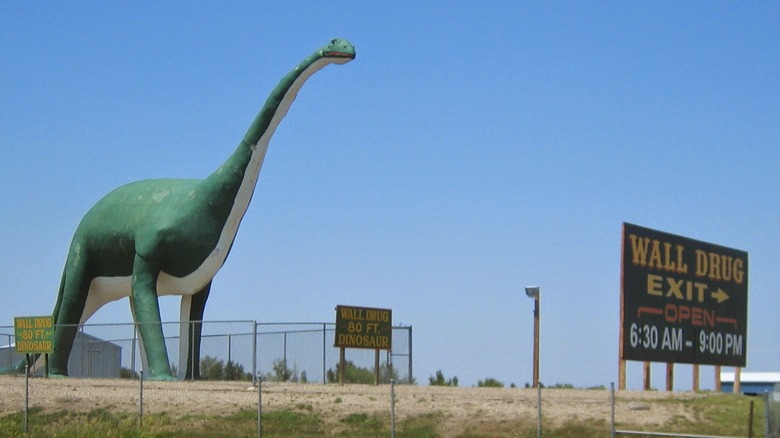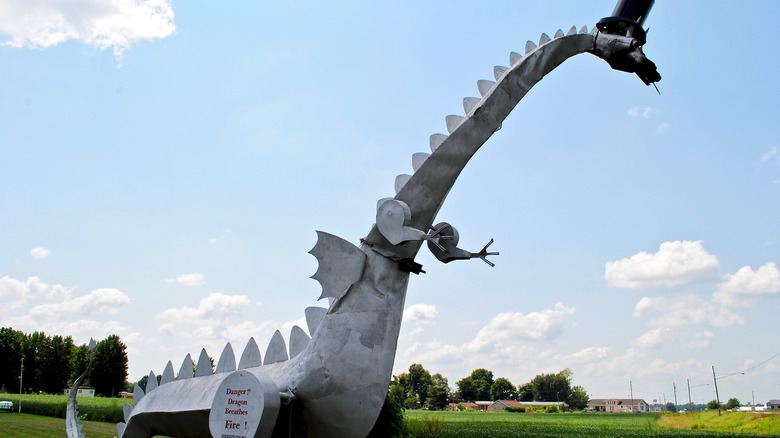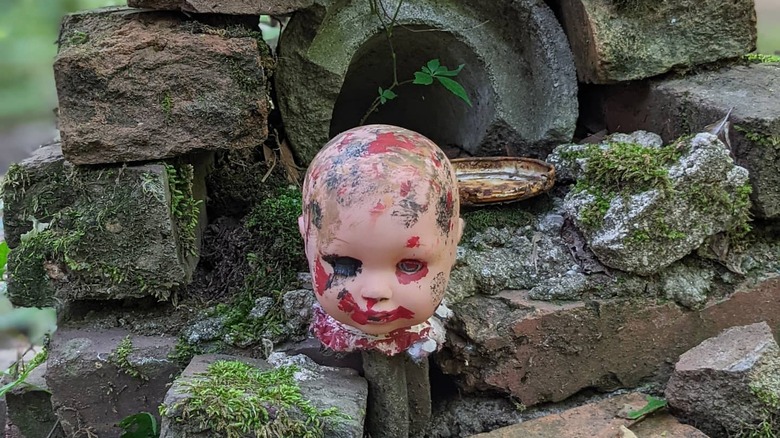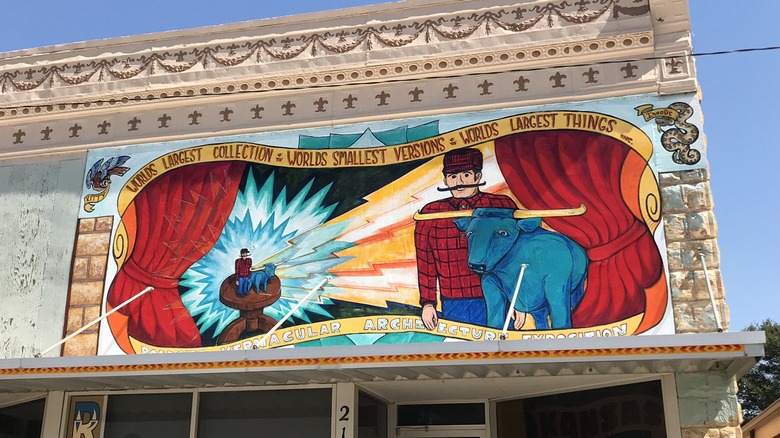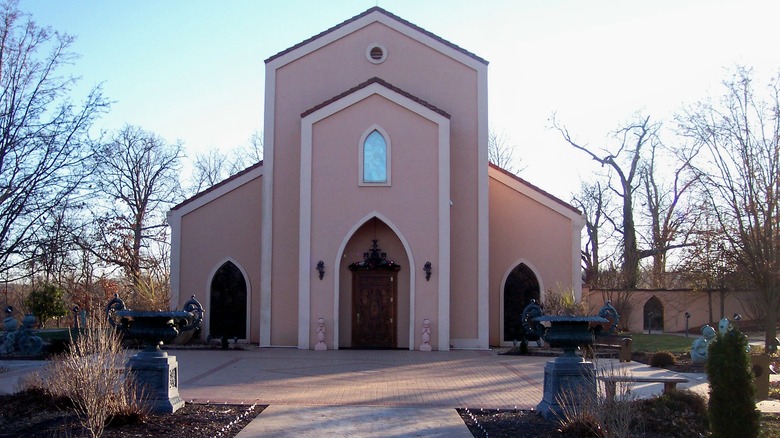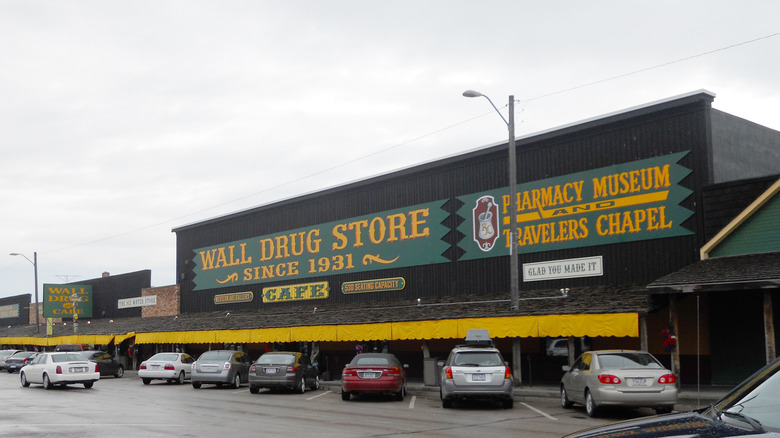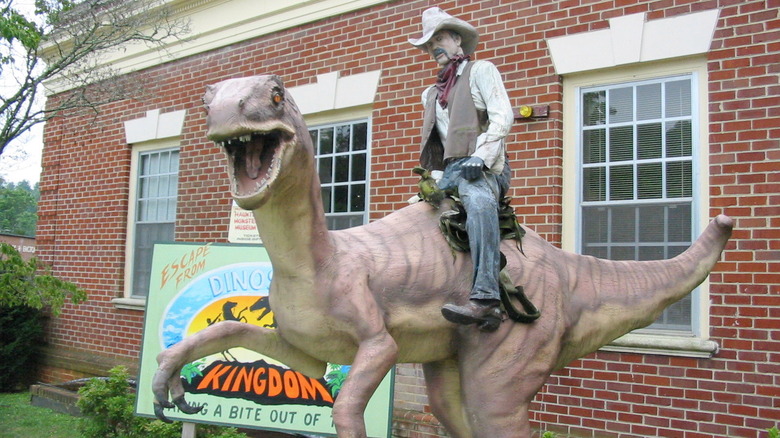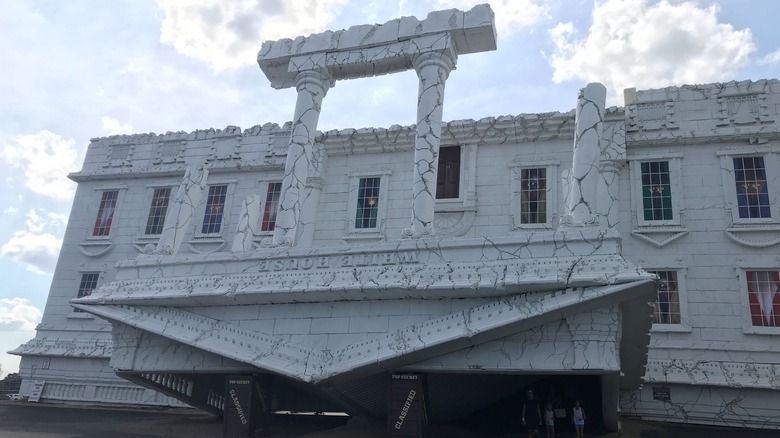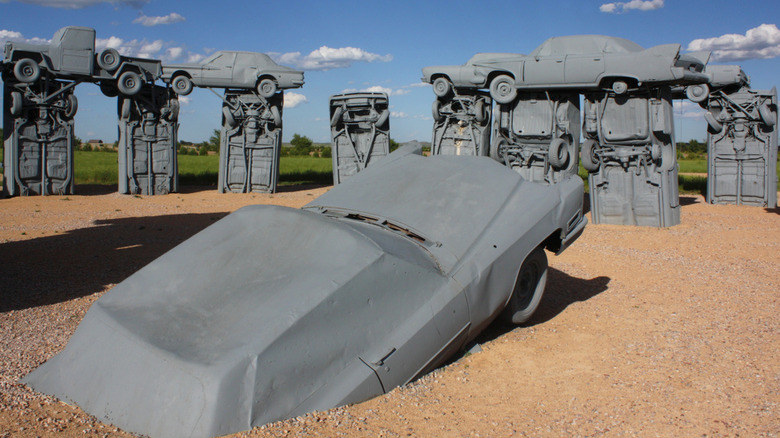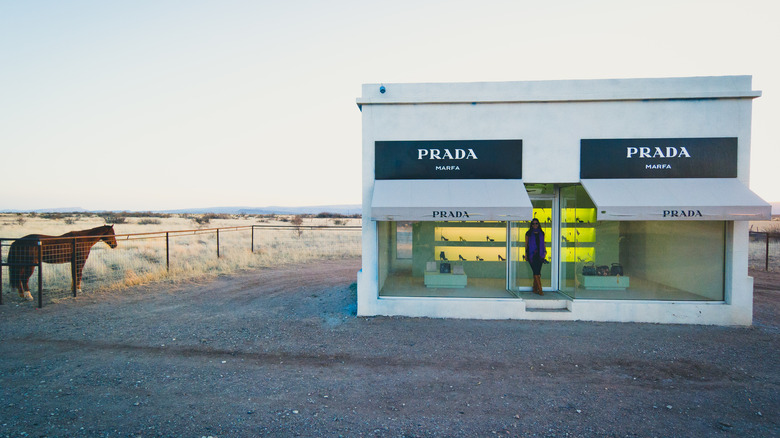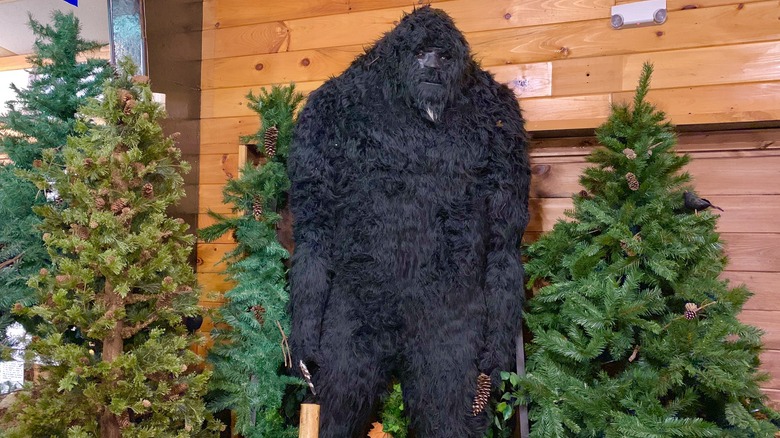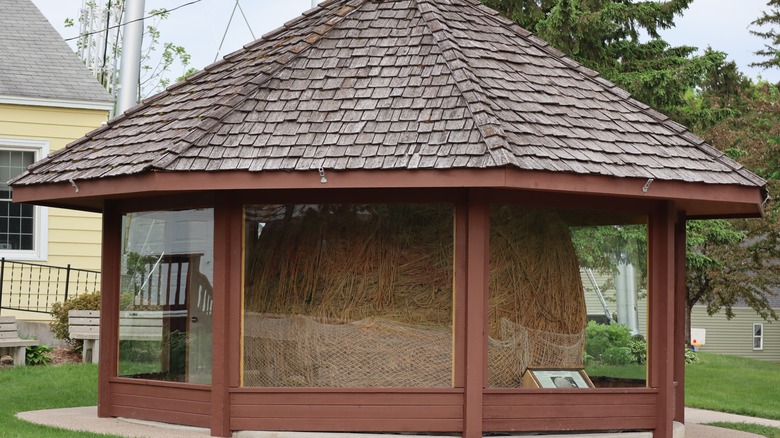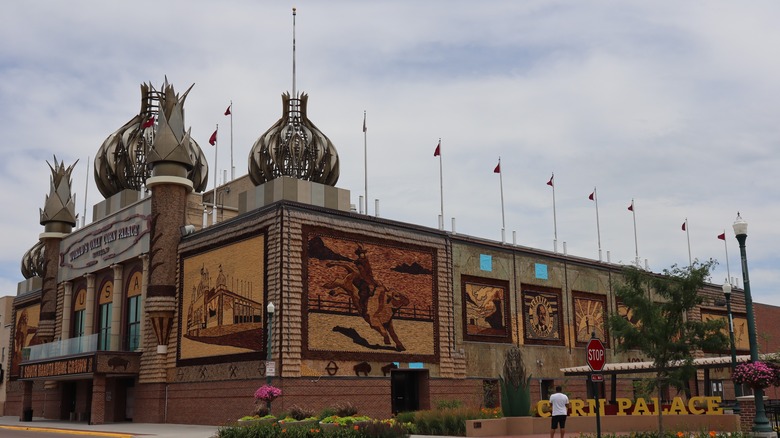The Strangest Roadside Attractions In America
According to the Federal Highway Administration, the United States has over 164,000 miles of highway as part of over 4 million miles of public roads stretching like a vast, asphalt circulatory system through the country. That's a lot of real estate, and some of it definitely gets more traffic than others. If you're looking to bring more people–and let's be real, more dollars–to your particular stretch of highway, you could do a lot worse than investing in some kind of roadside attraction: an unusual, mysterious, ridiculous, or often downright weird kind of something that will make people want to stop their cars and look, just so they can tell people they'd seen it.
America's highways are just absolutely littered with these kinds of ostentatious-yet-charming tourist traps of all types, ranging from the world's largest versions of everyday items to places that claim to have non-standard physics to lots and lots of concrete dinosaurs. While it would be impossible to collect every bit of weird roadside Americana, here is just a sampling of some of the strangest.
A fire-breathing metal dragon in Illinois
Readers of "The Hobbit" know that dragons famously love to hoard coins, and the metallic-skinned dragon that guards Rock Island Avenue in Vandalia, Illinois, is no exception. Known as the Kaskaskia Dragon, this 35-foot metal beast with red light bulbs for eyes will send forth a 10-second spout of flame for every $1 dragon coin it receives, handily sold at the liquor store across the street. As the dragon's creator Walt Barenfanger told Roadside America, the dragon was originally built in 1995 for a local Halloween parade during downtime at the Kaskaskia hardware store that Barenfanger owns. By 2001, Barenfanger realized it would be fun to set the dragon out by the side of the road down the block from the store. Soon, however, people demanded that the dragon should be able to breathe fire, so Barenfanger and a local propane expert created a system by which the dragon could be made to breathe fire via a self-service coin slot that takes special dragon coins.
These coins are available at the liquor store across the street, which works out well since the liquor store is open late and people often want to see the dragon breathe fire after dark. The dragon apparently uses up about one 20-pound propane tank a month, but you have to let the hardware store know if the dragon's flame has given out.
A hiking trail full of doll heads in Georgia
If you like hiking, outsider art, and the scenes from Toy Story with the mean kid's messed up toy experiments, has Atlanta got the spot for you. As Atlanta Trails explains, the Doll's Head Trail is a short, 1.6-mile loop through Constitution Lakes Park, an urban nature preserve that was previously the site of a 19th-century brick company that excavated red clay from the area. After the company ceased digging, the dug out pits filled with water and created a system of man-made ponds known as the Constitution Lakes. The Doll's Head Trail gets its name from the work of Joel Slaton, a local carpenter who decided to use the various trash and refuse from the old site–which apparently included a lot of doll parts for some reason–to create an art project in the preserve. The displays throughout the trail include either whimsical or creepy scenes made of doll parts, vintage toys, old bricks, fishing gear, antique railroad parts, and lots and lots of Sharpie ink.
There are even signs in the park encouraging hikers to add their own pieces of art to the collection but only using things found within the park itself, adding to the trail's unique folk art feel. While those with a doll phobia might be terrified at a display of disembodied, mud-covered doll parts, apparently the real danger is the many snakes that inhabit the wetland area.
Big little big things in Illinois
Perhaps the prototypical American roadside attraction is the "world's largest" whatever. Who wouldn't want to pull off the interstate to see the world's largest ball of paint, chainsaw, chest of drawers, or rocking chair? The kids are clamoring for it, Dad. They demand the giant chainsaw. The tiny town of Casey, Illinois, tries to stand out from the pack by having the World's Largest Collection of the World's Largest Objects, including a giant wind chime, golf tee, knitting needles, mailbox, and more. However, one collection in Lucas, Kansas, takes Casey's high concept one step higher (or lower?) by boasting the World's Largest Collection of the World's Smallest Versions of the World's Largest Things.
As Atlas Obscura explains, this giant collection of tiny big things isn't always in Lucas. It's actually a mobile exhibit inside a van owned by its creator, Erika Nelson. Nelson travels the U.S. looking for its most vaunted "world's largest" items, photographs them, and then makes tiny replica versions for her collection. Nelson's tiny big things include recreations of giant balls of twine, balls of rubber bands, donuts, corn cobs, wicker baskets, bananas, and more. As of 2017, there is a permanent installation for parts of the collection in downtown Lucas called the Roadside Sideshow Expo. For those hoping to visit, know that the museum is said to be open "by chance or appointment."
A chapel that looks like your grandma decorated it in Missouri
It's perhaps no surprise that the American highway system, somewhat famously sprinkled with billboards declaring the reality of Hell or the imminence of the end times, frequently in close proximity to adult bookstores, has its share of religious-themed roadside attractions. There's California's brightly colored Salvation Mountain, Alabama's miniature recreation of ancient Jerusalem (and more) known as the Ave Maria Grotto, Ohio's wax museum of Christianity BibleWalk, and giant statues of Jesus that look like they were carved out of butter in Arkansas and Ohio. But only one roadside stop dares to combine a love of Christ with an affection for kitschy religious collectibles of the 1980s: Precious Moments Chapel in Carthage, Missouri.
As Atlas Obscura explains, Precious Moments figurines–which have been called "Funko Pops for Boomers" by various online wags–were the creation of artist Samuel J. Butcher, whose artwork depicting various teardrop-eyed children with enormous heads served as the basis for a collectibles boom in the '80s and '90s. Butcher subsequently created a chapel and surrounding gardens to celebrate these weirdly proportioned children. Besides the titular chapel, which is filled with cartoons and frescoes in some strange homage to the Sistine Chapel, the complex contains various gardens, including memorial gardens dedicated to deceased children, a visitor center recording the history of Precious Moments, a cafe, and, of course, a gift shop. See if your grandma wants to go next time you're passing through southwestern Missouri.
South Dakota's king of all tourist traps
It would be difficult to name the all-time king of American roadside attractions and tourist traps, but any discussion that was trying to take the topic seriously would have to include Wall Drug in Wall, South Dakota. Any self-respecting tourist trap that's more than just a big thing on the side of the road lives in the long shadow of the drugstore in tiny Wall. As Atlas Obscura explains, Wall Drug was originally just the drugstore for a town of 231 people in South Dakota when it was purchased by Ted Hustead in 1931. However, two key things soon changed the store's destiny forever: Mount Rushmore opened 60 miles west of Wall, and Hustead's wife Dorothy suggested they should start advertising free ice water to thirsty travelers on their way to see the big president heads.
This simple promotion turned out to be a huge hit, drawing in loads of thirsty drivers, and soon the simple drug store expanded into a menagerie of wonders, including a host of taxidermied jackalopes, numerous life-size dinosaur statues, an animatronic cowboy orchestra, a replica monastery, and a singing gorilla man. True to its roots, Wall Drug still gives out some 20,000 cups of ice water a day to those who are either en route to Mount Rushmore or those who have seen the numerous billboards advertising the once-tiny drugstore to potential patrons as far as 500 miles away.
Extremely alternate history in Virginia
We can all agree that the coolest things that have ever been alive on this planet are dinosaurs, so it only stands to reason that some roadside attractions would target that most natural of human impulses: to look at rad dinosaurs. While many larger tourist traps such as South Dakota's Wall Drug or Arizona's Rainbow Rock Shop feature giant dinosaur statues as part of their collections of oddities, specifically dinosaur-focused attractions include Cave City, Kentucky's Dinosaur World and White Post, Virginia's Dinosaurland. But as cool as these must-see spots for sauropod sighting are, none of them reach quite the level of weirdness as Natural Bridge, Virginia's Dinosaur Kingdom II.
As the name implies, Dinosaur Kingdom II is a sequel of sorts to the original Dinosaur Kingdom, which burned down in 2012. What sets it apart from other dinosaur attractions, however, is that it is less concerned with historical or scientific accuracy than with creating truly memorable tableaus. As Atlas Obscura explains, Dinosaur Kingdom is the brainchild of fiberglass artist Mark Cline and depicts multiple scenes of an alternate history Civil War in which the Union Army was defeated and eaten by dinosaurs. An Allosaurus rips a Union soldier off his horse, another Yankee is swallowed by a snake, Abraham Lincoln fights a raptor at Gettysburg, and there's even a cyborg Stonewall Jackson, because why not.
Wisconsin's more interesting White House
According to Scholastic, the White House receives upwards of 6,000 visitors a day. Boring. Pedestrian. What are you going to see there? The President? Yawn. Anyone can go to Washington, D.C., and look at where legislation allegedly happens. But only real road warriors know the truth about the secret Upside-Down White House in the Wisconsin Dells, itself something of a tourist trap from stem to stern. As Roadside America explains, this topsy-turvy executive mansion–more properly known as Top Secret Inc.–claims to be the result of an archeological dig team attempting to uncover the secrets behind the upside-down nature of our universe. Visitors are led by a guide whose job is to attempt to explain the strange findings inside their team's strange excavation.
The tour includes some elements you would expect, such as an upside-down Oval Office and an inverted press room, though you might be somewhat alarmed to find a robot president promising forthcoming rule by robots. Other rooms contain a partially excavated Capitol dome and troughs full of skulls. Hallways lead to storage rooms containing Watergate tapes and the Ark of the Covenant, a rotating tunnel, and a laboratory where aliens are said to assemble each president, who have all been robots since the 1960s. Labyrinthine halls wind past nuclear missile silos, caged monsters, penned dinosaurs, and more. They probably don't let you see secrets like this when you go to the regular White House.
Monuments to cars in Nebraska and Texas
One of the most well-known monuments in the world is Stonehenge, the mysterious stone circle on England's Salisbury Plain, which is a true wonder of prehistoric engineering featuring a host of 25-ton stones carried from miles away to create some kind of monolithic calendar. As Atlas Obscura explains, experimental artist Jim Reinders decided in 1982 to pay homage to this ancient stone circle in the most American way he could think of: by building an accurate and proportional replica of the monument using old cars, creating the star of Alliance, Nebraska, Carhenge.
All 38 stones of the original Stonehenge are reproduced in Carhenge, with vehicles including cars, pickup trucks, an ambulance, and a classic Cadillac, all painted gray to better resemble the standing stones of Salisbury. In time, the roadside art piece has grown into a collection, featuring works from other artists, including a giant salmon and–of course–a dinosaur.
However, if you can't make it out to Nebraska, you could always seek out the similarly automobile-themed art attraction, Amarillo, Texas's Cadillac Ranch, which is made up of 10 Cadillacs covered in graffiti and buried nose-first "at the same angle as the Cheops' pyramids" in the middle of a field in Texas. Visitors are allowed and even encouraged to apply their own layer of graffiti to the cars, making it something of a living and evolving work of art.
The weirdest place to window-shop in Texas
According to Prada's website, the luxury brand has 410 stores spread out over basically every continent. One place it doesn't have a store–despite all appearances–is by the side of a little-traveled road in west Texas. The thing you think is a Prada store that actually isn't is Prada Marfa, a piece of conceptual art near the tiny town of Valentine, Texas. According to Atlas Obscura, Prada Marfa–named after the nearby town of Marfa, Texas–was the creation of Berlin-based artists Elmgreen and Dragset, who built a full-scale replica of a fully-stocked Prada store out of a biodegradable substance similar to adobe with the intent that over time this iconic symbol of capitalist materialism would slowly but surely melt back into the earth. It's a statement, you see.
The piece was created with the cooperation of Prada's own head designer, Miuccia Prada herself, who consulted on the design and hand-picked the items to go inside, as well as–perhaps most importantly–allowing the use of the Prada name and logo. As you might expect, a store full of luxury goods next to an empty street with no other buildings in sight became an easy target for vandals and thieves. Shortly after the installation's much-publicized opening in 2005, the store was looted and vandalized, but it has been rebuilt with better security and stronger windows. Also, thieves take note: the shoes are all righties and the bags have no bottoms.
Georgia's quest to see Bigfoot's butt
Certain subsets of America are deeply obsessed with cryptids–that is, mysterious creatures that may or may not exist–whether they want to find them for science, hunt them for dinner, or make out with them big time, so it's not surprising that museums dedicated to the search for strange creatures dot this vast American landscape. These include Portland, Maine's International Cryptozoology Museum, and Point Pleasant, West Virginia's Mothman Museum, but the most famous cryptid of them all can best be found (so to speak) and studied at Expedition Bigfoot, the Sasquatch Museum in Cherry Log, Georgia.
According to Atlas Obscura, this northern Georgia museum contains one of the largest collections of Bigfoot evidence, information, folklore, and memorabilia in the world. The 4,000 square foot museum's collection includes numerous newspaper articles documenting sightings of America's most famous cryptid, as well as casts created from alleged hand- and footprints of the so-called missing link. Another crucial piece of evidence within the museum is a sample of Sasquatch feces gathered in Oregon in 2016. If you're still skeptical after all that, however, your time won't have been wasted, because there are free cookies for all visitors. For a certain brand of cryptid-hunter, however, there is one extremely crucial piece of evidence that will be worth traveling to Georgia for: a plaster cast that proves once and for all what Bigfoot's butt looks like.
Dueling balls of twine
The actual world's largest ball of twine is in Cawker City, Kansas. As Roadside America explains, this twine ball was begun in 1953 when farmer Frank Stoeber decided to wind up all his spare twine instead of burning it, which is the normal procedure. Within three years, he had a ball seven feet in diameter weighing two tons. By the 1960s, the giant twine ball–even more giant by this point as Stoeber kept adding to it–was such a popular attraction that it was given a permanent display on a sheltered slab of concrete by U.S. Highway 24. When Stoeber died in 1973, his twine ball had been Guinness-certified as the world's largest. However, five years later, Stoeber's ball was knocked out of first by a contender a few states away in Minnesota.
Roadside America says that the Biggest Ball of Twine in Minnesota was begun by farmer Francis A. Johnson in Darwin, Minnesota, which he added to using twine donated by neighboring farmers and wound into a ball using equipment designed to lift boxcars. After Johnson's death in 1989, the giant ball was moved to the center of downtown Darwin, where it weighed in at almost nine tons. Since then, the Kansas ball has been added to and reclaimed its crown, but only one twine ball has a song about it by "Weird Al" Yankovic, so we all know who the real winner is.
Finally, a chance to look at corn in South Dakota
If you've ever driven through the American Midwest, you have probably seen more corn than anything else. Just niblets as far as the eye can see. As such, it will probably not surprise you that a monument to America's yellow gold has been erected in the midst of this wide belt of maize, Mitchell, South Dakota's own Corn Palace. As Atlas Obscura explains, the Corn Palace was first constructed in Mitchell–the self-proclaimed "Corn Capital of the World"–in 1892 as a promotional attraction to draw attention to South Dakota's rich and fertile soil. Since then, the Palace has been rebuilt and added to a number of times, including as part of a 1905 attempt by the municipal Mitchell government to move the state capital there. The now-iconic Russian-style onion domes and minarets were added in 1937.
While the Palace itself is not actually made of corn, its exterior is covered in enormous murals made of corn cobs and other local grasses and grains. Each year the murals are dedicated to a particular theme, such as "Life on the Farm," "South Dakota Weather," "Salute to Rodeo," or "Rock of Ages." Despite sounding like it should theoretically be the ancestral home for a monarchical corn dynasty of some kind, the Corn Palace is actually used as a convention center and venue for sports and music. Each year, half a million people visit, more than 30 times the population of Mitchell.
